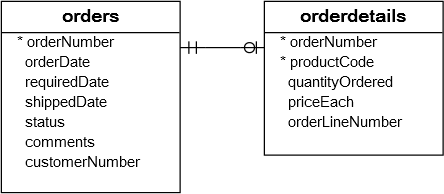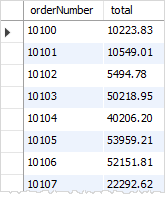Summary: in this tutorial, you will learn how to use MySQL GROUP BY to group rows into groups based on the values of columns or expressions.
Introduction to MySQL GROUP BY clause
The GROUP BY clause groups rows into summary rows based on column values or expressions. It returns one row for each group and reduces the number of rows in the result set.
The GROUP BY clause is an optional part of the SELECT statement. The following illustrates the syntax of the GROUP BY clause:
SELECT
c1, c2,..., cn, aggregate_function(ci)
FROM
table_name
WHERE
conditions
GROUP BY c1 , c2,...,cn;Code language: SQL (Structured Query Language) (sql)In this syntax, you place the GROUP BY clause after the FROM and WHERE clauses. Following the the GROUP BY keywords, you list the columns or expressions you want to group, separated by commas.
MySQL evaluates the GROUP BY clause after the FROM and WHERE clauses but before the HAVING, SELECT, DISTINCT, ORDER BY and LIMIT clauses:
In practice, you often use the GROUP BY clause with aggregate functions such as SUM, AVG, MAX, MIN, and COUNT. The aggregate function that appears in the SELECT clause provides the information for each group.
MySQL GROUP BY examples
Let’s look at some examples of using the GROUP BY clause.
1) Basic MySQL GROUP BY example
We’ll use the orders table in the sample database:
If you want to group the order statuses, you can use the GROUP BY clause with the status column in the following query:
SELECT
status
FROM
orders
GROUP BY
status;Code language: SQL (Structured Query Language) (sql)Output:
+------------+
| status |
+------------+
| Shipped |
| Resolved |
| Cancelled |
| On Hold |
| Disputed |
| In Process |
+------------+
6 rows in set (0.02 sec)Code language: SQL (Structured Query Language) (sql)The output shows that the GROUP BY clause returns unique occurrences of the values in the status columns.
It works like the DISTINCT operator, as demonstrated in the following query:
SELECT
DISTINCT status
FROM
orders;Code language: SQL (Structured Query Language) (sql)2) Using MySQL GROUP BY with aggregate functions
In practice, you often use the GROUP BY clause with an aggregate function to group rows into sets and return a single value for each group.
An aggregate function calculates a set of rows and returns a single value.
For example, to obtain the number of orders in each status, you can use the COUNT function with the GROUP BY clause as follows:
SELECT
status,
COUNT(*)
FROM
orders
GROUP BY
status;Code language: SQL (Structured Query Language) (sql)+------------+----------+
| status | COUNT(*) |
+------------+----------+
| Shipped | 303 |
| Resolved | 4 |
| Cancelled | 6 |
| On Hold | 4 |
| Disputed | 3 |
| In Process | 6 |
+------------+----------+
6 rows in set (0.01 sec)Code language: SQL (Structured Query Language) (sql)See the following orders and orderdetails table from the sample database:

To get the total amount of all orders by status, you join the orders table with the orderdetails table and use the SUM function to calculate the total amount:
SELECT
status,
SUM(quantityOrdered * priceEach) AS amount
FROM
orders
INNER JOIN orderdetails USING (orderNumber)
GROUP BY
status;Code language: SQL (Structured Query Language) (sql)+------------+------------+
| status | amount |
+------------+------------+
| Shipped | 8865094.64 |
| Resolved | 134235.88 |
| Cancelled | 238854.18 |
| On Hold | 169575.61 |
| Disputed | 61158.78 |
| In Process | 135271.52 |
+------------+------------+
6 rows in set (0.01 sec)Code language: SQL (Structured Query Language) (sql)Similarly, the following query returns the order numbers and the total amount of each order.
SELECT
orderNumber,
SUM(quantityOrdered * priceEach) AS total
FROM
orderdetails
GROUP BY
orderNumber;Code language: SQL (Structured Query Language) (sql)
3) MySQL GROUP BY with expression example
In addition to columns, you can group rows by expressions. The following query calculates the total sales for each year:
SELECT
YEAR(orderDate) AS year,
SUM(quantityOrdered * priceEach) AS total
FROM
orders
INNER JOIN orderdetails USING (orderNumber)
WHERE
status = 'Shipped'
GROUP BY
YEAR(orderDate);Code language: SQL (Structured Query Language) (sql)+------+------------+
| year | total |
+------+------------+
| 2003 | 3223095.80 |
| 2004 | 4300602.99 |
| 2005 | 1341395.85 |
+------+------------+
3 rows in set (0.02 sec)Code language: SQL (Structured Query Language) (sql)In this example, we used the YEAR function to extract year data from order date ( orderDate) and included only orders with shipped status in the total sales.
Note that the expression in the SELECT clause must match the one in the GROUP BY clause.
4) Using MySQL GROUP BY with HAVING clause example
To filter the groups returned by GROUP BY clause, you use a HAVING clause.
The following query uses the HAVING clause to select the total sales of the years after 2003.
SELECT
YEAR(orderDate) AS year,
SUM(quantityOrdered * priceEach) AS total
FROM
orders
INNER JOIN orderdetails USING (orderNumber)
WHERE
status = 'Shipped'
GROUP BY
year
HAVING
year > 2003;Code language: SQL (Structured Query Language) (sql)
5) Grouping by multiple columns
The following query returns the year, order status, and the total order for each combination of year and order status by grouping rows into groups:
SELECT
YEAR(orderDate) AS year,
status,
SUM(quantityOrdered * priceEach) AS total
FROM
orders
INNER JOIN orderdetails USING (orderNumber)
GROUP BY
year,
status
ORDER BY
year;Code language: SQL (Structured Query Language) (sql)Output:
+------+------------+------------+
| year | status | total |
+------+------------+------------+
| 2003 | Cancelled | 67130.69 |
| 2003 | Resolved | 27121.90 |
| 2003 | Shipped | 3223095.80 |
| 2004 | Cancelled | 171723.49 |
| 2004 | On Hold | 23014.17 |
| 2004 | Resolved | 20564.86 |
| 2004 | Shipped | 4300602.99 |
| 2005 | Disputed | 61158.78 |
| 2005 | In Process | 135271.52 |
| 2005 | On Hold | 146561.44 |
| 2005 | Resolved | 86549.12 |
| 2005 | Shipped | 1341395.85 |
+------+------------+------------+
12 rows in set (0.01 sec)Code language: SQL (Structured Query Language) (sql)The GROUP BY clause: MySQL vs. SQL standard
The SQL standard does not allow you to use an alias in the GROUP BY clause whereas MySQL supports this.
For example, the following query extracts the year from the order date. It first uses the year as an alias of the expression YEAR(orderDate) and then uses the year alias in the GROUP BY clause.
The following query is not valid in SQL standard:
SELECT
YEAR(orderDate) AS year,
COUNT(orderNumber)
FROM
orders
GROUP BY
year;Code language: SQL (Structured Query Language) (sql)+------+--------------------+
| year | COUNT(orderNumber) |
+------+--------------------+
| 2003 | 111 |
| 2004 | 151 |
| 2005 | 64 |
+------+--------------------+
3 rows in set (0.00 sec)Code language: SQL (Structured Query Language) (sql)The GROUP BY clause vs. DISTINCT clause
If you use the GROUP BY clause in the SELECT statement without using aggregate functions, the GROUP BY clause behaves like the DISTINCT clause.
The following statement uses the GROUP BY clause to select the unique states of customers from the customers table.
SELECT
state
FROM
customers
GROUP BY
state;Code language: SQL (Structured Query Language) (sql)+---------------+
| state |
+---------------+
| NULL |
| NV |
| Victoria |
| CA |
| NY |
| PA |
| CT |
...Code language: SQL (Structured Query Language) (sql)You can achieve a similar result by using the DISTINCT clause:
SELECT
DISTINCT state
FROM
customers;Code language: SQL (Structured Query Language) (sql)+---------------+
| state |
+---------------+
| NULL |
| NV |
| Victoria |
| CA |
| NY |
| PA |
| CT |
...
Code language: SQL (Structured Query Language) (sql)Notice that MySQL 8.0 or later removed the implicit sorting for the GROUP BY clause. Therefore, if you are using earlier versions, you will find that the result set with the GROUP BY clause is sorted.
Summary
- Use the
GROUP BYclause to group rows into subgroups.